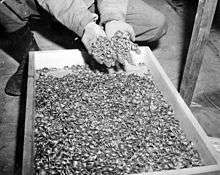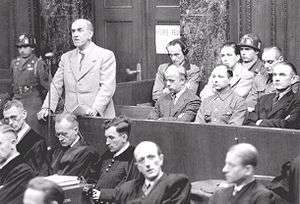SS Main Economic and Administrative Office
|
SS-Wirtschafts-Verwaltungshauptamt SS-WVHA | |
|
The WVHA was an office of the SS | |
 Reichsführer-SS Heinrich Himmler inspects building works that had been undertaken by forced-labor prisoners in 1940. | |
| Agency overview | |
|---|---|
| Formed | 1942 |
| Preceding agencies |
|
| Dissolved | May 8, 1945 |
| Jurisdiction |
Occupied Europe |
| Headquarters |
Wirtschafts-Verwaltungshauptamt, Unter den Eichen 125-135, Lichterfelde, Berlin 52°27′5.12″N 13°18′35.24″E / 52.4514222°N 13.3097889°E |
| Minister responsible |
|
| Agency executive |
|
| Parent agency |
|
The SS Main Economic and Administrative Office (SS-Wirtschafts- und Verwaltungshauptamt), abbreviated SS-WVHA, was a Nazi organization responsible for managing the finances, supply systems and business projects for the Allgemeine-SS. It also ran the concentration camps and was instrumental in the implementation of the Final Solution through such subsidiary offices as the Concentration Camps Inspectorate and SS camp guards.
Economics of The Holocaust
SS-Obergruppenführer Oswald Pohl worked with Walther Funk, Reich Minister of Economics (German: Reichswirtschaftsminister), to oversee financial aspects of the Final Solution, the most deadly phase of The Holocaust. Valuables such as gold watches, rings, even tooth fillings, glasses, and currency were taken from the inmates on arrival at the death camps. These items were then sent back to Berlin in WVHA-marked crates for processing at the Reichsbank, under its director Emil Puhl.[1] Between August 1942 and January 1945, a total of 76 WVHA transports arrived in Berlin.
In 1947, a detailed description showing the scale of the operation was given at the WVHA trials at Nuremberg. Evidence outlined how property and cash worth hundreds of millions of Reichsmarks was taken from the victims of Aktion Reinhard. It was collected from the detailed notes that had passed between SS and Police Leader Odilo Globocnik and Reichsführer-SS Heinrich Himmler during the operation to kill most of the Jews in the General Government.[1]
Organization
The WVHA grew out of the Verwaltung und Wirtschaftshauptamt Hauptamt (VuWHA; Administration and Business office) which was set up under the control of Oswald Pohl. He oversaw all SS "construction projects and building enterprises" through that office and the other one he controlled, which was known as the Hauptamt Haushalt und Bauten (Main office [for] budget and construction).[2] The administration of the concentration camps, its guard units and slave labor the camps produced were included.[2] Then in 1942, Himmler consolidated all of the offices for which Pohl was responsible into one, creating the SS Main Economic and Administrative Office (Wirtschafts- und Verwaltungshauptamt; WVHA).[3] The WVHA was made up of five main departments (German: Ämter or Amtsgruppe):
- Amt A, Finance, Law and Administration
- Amt B, Supply, Administration and Equipment
- Amt C, Buildings and Works
- Amt D, Concentration Camps (SS-TV under SS Gruppenfuhrer Richard Glücks)
- Amt W, Economics
The WVHA was also put in charge of numerous commercial ventures that the SS has been increasingly engaged in since the mid-1930s.
Amtsgruppe W

In 1942, the WVHA's main remit was to expand the SS's contribution to the war effort by using forced labor in armaments manufacture and construction projects. From these requirements grew the Amt W (Economics), the largest and most valuable division in WVHA. Using a limitless supply of slave labor provided by the concentration camps, the Amt W was in a position to produce and deliver large quantities of products cheaply and quickly to the German market. Initially working prisoners in Arbeitslager (English: Work Camp) were given better conditions than usual. But by late 1942, the Amt W demanded higher work rates without increasing food rations or providing better living conditions. As a result, SS guards used murderous brutality to achieve higher quotas from forced labor in Strafkompanies.
Amt W controlled the entire product cycle—from extraction of raw materials to manufacture and distribution—either directly or through a complex network of shell companies set up by Pohl as privately owned businesses. After the invasion of the Soviet Union, the SS also gained operational control of the majority of the Soviet manufacturing and mining assets on occupied territories.
The concentration camps gave the WVHA an unlimited labor resource. Amt W negotiated contracts with industrial firms regarding the use of slave labor in their factories. Arrangements covered the number of prisoners needed, the type of work they did, the number of SS guards to be assigned to the detail, food and lodging for the prisoners as well as the amount of money the firms would pay the SS for each prisoner per day.
Slave labor for private companies, included Heinkel, IG Farben, Junkers, Krupp, Messerschmitt, Salzgitter, and Siemens-Schuckertwerke. At locations like Mauthausen and Gusen at St. Georgen, Pohl managed successfully to make leading armament producers like Messerschmitt GmbH or Steyr-Daimler-Puch fully dependable on deliveries by companies of Amtsgruppe W. Additionally, the SS was producing under contract military clothing and equipment for the Wehrmacht.
By 1945, the SS-WVHA controlled over 500 businesses throughout Germany, with some products dominating entire markets such as Apollinaris mineral water, Allach porcelain or DEST (building material and armament).
SS commercial operations

Some commercial ventures and assets owned or operated by the SS through its SS-WVHA units:
- Land and forests
- Brick factories
- Stone quarries
- Fine porcelain and pottery factories
- Building materials factories
- Cement factory
- Mineral water extraction and bottling
- Meat processing
- Bakeries
- Small arms manufacturing and repair
- Wooden furniture design and production
- Military clothing and accessories
- Herbal medicine
- Fish processing
- Publishing of books and magazines on Germanic culture and history
- Art acquisition and restoration
- Production of Damascus blades
See also
Notes
- 1 2 "Nuremberg Trial Proceedings Volume 20, Day 195, Aug 5 1946".
- 1 2 Weale 2012, p. 115.
- ↑ Longerich 2012, p. 559.
References
- Longerich, Peter (2012). Heinrich Himmler: A Life. Oxford: Oxford University Press. ISBN 978-0-199-59232-6.
- Reiner Merkel: Hans Kammler - Manager des Todes, 2010 August von Goethe Literaturverlag, Frankfurt am Main, ISBN 978-3-8372-0817-7.
- Weale, Adrian (2012). Army of Evil: A History of the SS. New York; Toronto: NAL Caliber (Penguin Group). ISBN 978-0-451-23791-0.
External links
- The Building today (former WVHA) at Berlin Lichterfelde) and Informationsdesks (1999; R. Golz)
